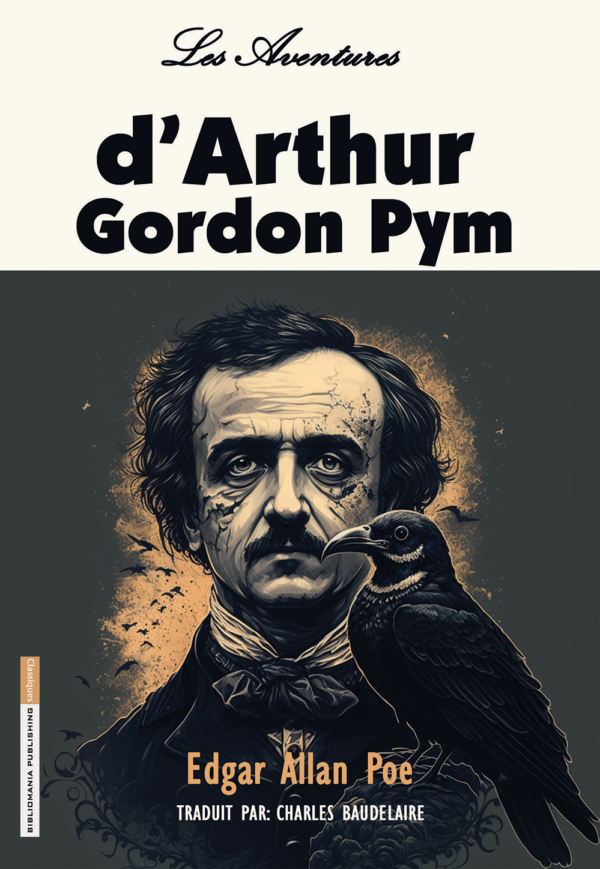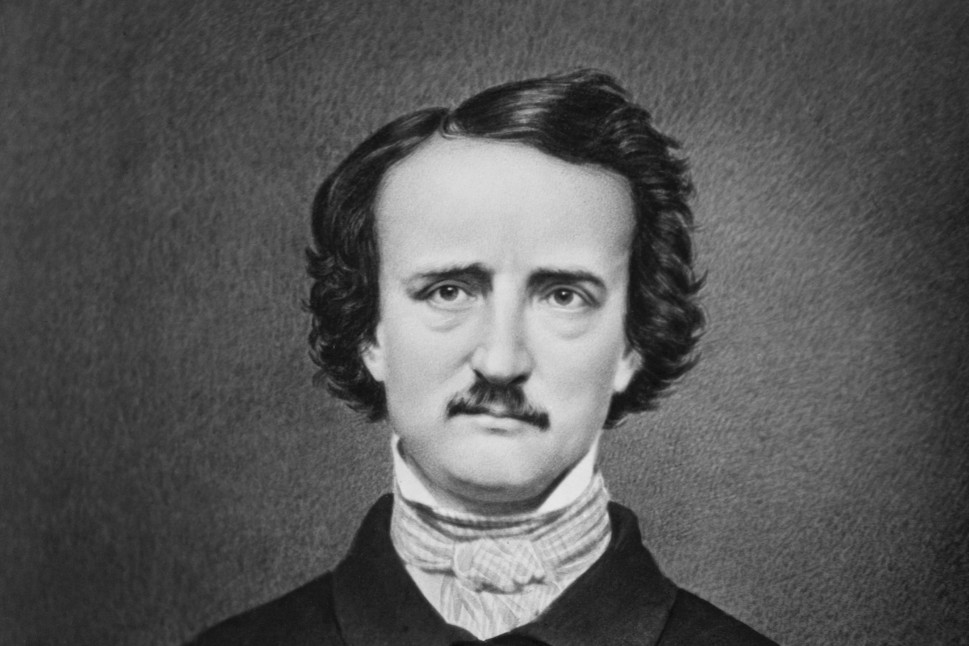
Les aventures d’Arthur Gordon Pym de Nantucket
EGP 650.00 السعر الأصلي هو: EGP 650.00.EGP 350.00السعر الحالي هو: EGP 350.00.
الكاتب
-

Edgar Allan Poe’s stature as a major figure in world literature is primarily based on his ingenious and profound short stories, poems, and critical theories, which established a highly influential rationale for the short form in both poetry and fiction. Regarded in literary histories and handbooks as the architect of the modern short story, Poe was also the principal forerunner of the “art for art’s sake” movement in 19th-century European literature. Whereas earlier critics predominantly concerned themselves with moral or ideological generalities, Poe focused his criticism on the specifics of style and construction that contributed to a work’s effectiveness or failure. In his own work, he demonstrated a brilliant command of language and technique as well as an inspired and original imagination. Poe’s poetry and short stories greatly influenced the French Symbolists of the late 19th century, who in turn altered the direction of modern literature. Poe’s father and mother were professional actors. At the time of his birth in 1809, they were members of a repertory company in Boston. Before Poe was three years old both of his parents died, and he was raised in the home of John Allan, a prosperous exporter from Richmond, Virginia, who never legally adopted his foster son. As a boy, Poe attended the best schools available, and was admitted to the University of Virginia at Charlottesville in 1825. While there he distinguished himself academically but was forced to leave after less than a year because of bad debts and inadequate financial support from Allan. Poe’s relationship with Allan disintegrated upon his return to Richmond in 1827, and soon after Poe left for Boston, where he enlisted in the army and also published his first poetry collection, Tamerlane, and Other Poems. The volume went unnoticed by readers and reviewers, and a second collection, Al Aaraaf, Tamerlane, and Minor Poems, received only slightly more attention when it appeared in 1829. That same year Poe was honorably discharged from the army, having attained the rank of regimental sergeant major, and was then admitted to the United States Military Academy at West Point. However, because Allan would neither provide his foster son with sufficient funds to maintain himself as a cadet nor give the consent necessary to resign from the Academy, Poe gained a dismissal by ignoring his duties and violating regulations. He subsequently went to New York City, where Poems, his third collection of verse, was published in 1831, and then to Baltimore, where he lived at the home of his aunt, Mrs. Maria Clemm. Over the next few years Poe’s first short stories appeared in the Philadelphia Saturday Courier and his “MS. Found in a Bottle” won a cash prize for best story in the Baltimore Saturday Visitor. Nevertheless, Poe was still not earning enough to live independently, nor did Allan’s death in 1834 provide him with an inheritance. The following year, however, his financial problems were temporarily alleviated when he accepted an editorship at The Southern Literary Messenger in Richmond, bringing with him his aunt and his 12-year-old cousin Virginia, whom he married in 1836. The Southern Literary Messenger was the first of several journals Poe would direct over the next 10 years and through which he rose to prominence as a leading man of letters in America. Poe made himself known not only as a superlative author of poetry and fiction, but also as a literary critic whose level of imagination and insight had hitherto been unapproached in American literature. While Poe’s writings gained attention in the late 1830s and early 1840s, the profits from his work remained meager, and he supported himself by editing Burton’s Gentleman’s Magazine and Graham’s Magazine in Philadelphia and the Broadway Journal in New York City. After his wife’s death from tuberculosis in 1847, Poe became involved in a number of romantic affairs. It was while he prepared for his second marriage that Poe, for reasons unknown, arrived in Baltimore in late September of 1849. On October 3, he was discovered in a state of semi-consciousness; he died four days later without regaining the necessary lucidity to explain what had happened during the last days of his life. Poe’s most conspicuous contribution to world literature derives from the analytical method he practiced both as a creative author and as a critic of the works of his contemporaries. His self-declared intention was to formulate strictly artistic ideals in a milieu that he thought overly concerned with the utilitarian value of literature, a tendency he termed the “heresy of the Didactic.” While Poe’s position includes the chief requisites of pure aestheticism, his emphasis on literary formalism was directly linked to his philosophical ideals: through the calculated use of language one may express, though always imperfectly, a vision of truth and the essential condition of human existence. Poe’s theory of literary creation is noted for two central points: first, a work must create a unity of effect on the reader to be considered successful; second, the production of this single effect should not be left to the hazards of accident or inspiration, but should to the minutest detail of style and subject be the result of rational deliberation on the part of the author. In poetry, this single effect must arouse the reader’s sense of beauty, an ideal that Poe closely associated with sadness, strangeness, and loss; in prose, the effect should be one revelatory of some truth, as in “tales of ratiocination” or works evoking “terror, or passion, or horror.” Aside from a common theoretical basis, there is a psychological intensity that is characteristic of Poe’s writings, especially the tales of horror that comprise his best and best-known works. These stories—which include “The Black Cat,” “The Cask of Amontillado,” and “The Tell-Tale Heart”—are often told by a first-person narrator, and through this voice Poe probes the workings of a character’s psyche. This technique foreshadows the psychological explorations of Fyodor Dostoyevsky and the school of psychological realism. In his Gothic tales, Poe also employed an essentially symbolic, almost allegorical method which gives such works as “The Fall of the House of Usher,” “The Masque of the Red Death,” and “Ligeia” an enigmatic quality that accounts for their enduring interest and links them with the symbolical works of Nathaniel Hawthorne and Herman Melville. The influence of Poe’s tales may be seen in the work of later writers, including Ambrose Bierce and H.P. Lovecraft, who belong to a distinct tradition of horror literature initiated by Poe. In addition to his achievement as creator of the modern horror tale, Poe is also credited with parenting two other popular genres: science fiction and the detective story. In such works as “The Unparalleled Adventure of Hans Pfaall” and “Von Kempelen and His Discovery,” Poe took advantage of the fascination for science and technology that emerged in the early 19th century to produce speculative and fantastic narratives which anticipate a type of literature that did not become widely practiced until the 20th century. Similarly, Poe’s three tales of ratiocination—“The Murders in the Rue Morgue,” “The Purloined Letter,” and “The Mystery of Marie Roget”—are recognized as the models which established the major characters and literary conventions of detective fiction, specifically the amateur sleuth who solves a crime that has confounded the authorities and whose feats of deductive reasoning are documented by an admiring associate. Just as Poe influenced many succeeding authors and is regarded as an ancestor of such major literary movements as Symbolism and Surrealism, he was also influenced by earlier literary figures and movements. In his use of the demonic and the grotesque, Poe evidenced the impact of the stories of E.T.A. Hoffman and the Gothic novels of Ann Radcliffe, while the despair and melancholy in much of his writing reflects an affinity with the Romantic movement of the early 19th century. It was Poe’s particular genius that in his work he gave consummate artistic form both to his personal obsessions and those of previous literary generations, at the same time creating new forms which provided a means of expression for future artists. While Poe is most often remembered for his short fiction, his first love as a writer was poetry, which he began writing during his adolescence. His early verse reflects the influence of such English romantics as Lord Byron, John Keats, and Percy Bysshe Shelley, yet foreshadows his later poetry which demonstrates a subjective outlook and surreal, mystic vision. “Tamerlane” and “Al Aaraaf” exemplify Poe’s evolution from the portrayal of Byronic heroes to the depiction of journeys within his own imagination and subconscious. The former piece, reminiscent of Byron’s “Childe Harold’s Pilgrimage,” recounts the life and adventures of a 14th-century Mongol conqueror; the latter poem portrays a dreamworld where neither good nor evil permanently reside and where absolute beauty can be directly discerned. In other poems—“To Helen,” “Lenore,” and “The Raven” in particular—Poe investigates the loss of ideal beauty and the difficulty in regaining it. These pieces are usually narrated by a young man who laments the untimely death of his beloved. “To Helen” is a three stanza lyric that has been called one of the most beautiful love poems in the English language. The subject of the work is a woman who becomes, in the eyes of the narrator, a personification of the classical beauty of ancient Greece and Rome. “Lenore” presents ways in which the dead are best remembered, either by mourning or celebrating life beyond earthly boundaries. In “The Raven,” Poe successfully unites his philosophical and aesthetic ideals. In this psychological piece, a young scholar is emotionally tormented by a raven’s ominous repetition of “Nevermore” in answer to his question about the probability of an afterlife with his deceased lover. Charles Baudelaire noted in his introduction to the French edition of “The Raven”: “It is indeed the poem of the sleeplessness of despair; it lacks nothing: neither the fever of ideas, nor the violence of colors, nor sickly reasoning, nor drivelling terror, nor even the bizarre gaiety of suffering which makes it more terrible.” Poe also wrote poems that were intended to be read aloud. Experimenting with combinations of sound and rhythm, he employed such technical devices as repetition, parallelism, internal rhyme, alliteration, and assonance to produce works that are unique in American poetry for their haunting, musical quality. In “The Bells,” for example, the repetition of the word “bells” in various structures accentuates the unique tonality of the different types of bells described in the poem. While his works were not conspicuously acclaimed during his lifetime, Poe did earn due respect as a gifted fiction writer, poet, and man of letters, and occasionally he achieved a measure of popular success, especially following the appearance of “The Raven.” After his death, however, the history of his critical reception becomes one of dramatically uneven judgments and interpretations. This state of affairs was initiated by Poe’s one-time friend and literary executor R.W. Griswold, who, in a libelous obituary notice in the New York Tribune bearing the byline “Ludwig,” attributed the depravity and psychological aberrations of many of the characters in Poe’s fiction to Poe himself. In retrospect, Griswold’s vilifications seem ultimately to have elicited as much sympathy as censure with respect to Poe and his work, leading subsequent biographers of the late 19th century to defend, sometimes too devotedly, Poe’s name. It was not until the 1941 biography by A.H. Quinn that a balanced view was provided of Poe, his work, and the relationship between the author’s life and his imagination. Nevertheless, the identification of Poe with the murderers and madmen of his works survived and flourished in the 20th century, most prominently in the form of psychoanalytical studies such as those of Marie Bonaparte and Joseph Wood Krutch. Added to the controversy over the sanity, or at best the maturity of Poe (Paul Elmer More called him “the poet of unripe boys and unsound men”), was the question of the value of Poe’s works as serious literature. At the forefront of Poe’s detractors were such eminent figures as Henry James, Aldous Huxley, and T.S. Eliot, who dismissed Poe’s works as juvenile, vulgar, and artistically debased; in contrast, these same works have been judged to be of the highest literary merit by such writers as Bernard Shaw and William Carlos Williams. Complementing Poe’s erratic reputation among English and American critics is the more stable, and generally more elevated opinion of critics elsewhere in the world, particularly in France. Following the extensive translations and commentaries of Charles Baudelaire in the 1850s, Poe’s works were received with a peculiar esteem by French writers, most profoundly those associated with the late 19th-century movement of Symbolism, who admired Poe’s transcendent aspirations as a poet; the 20th-century movement of Surrealism, which valued Poe’s bizarre and apparently unruled imagination; and such figures as Paul Valéry, who found in Poe’s theories and thought an ideal of supreme rationalism. In other countries, Poe’s works have enjoyed a similar regard, and numerous studies have been written tracing the influence of the American author on the international literary scene, especially in Russia, Japan, Scandinavia, and Latin America. Today, Poe is recognized as one of the foremost progenitors of modern literature, both in its popular forms, such as horror and detective fiction, and in its more complex and self-conscious forms, which represent the essential artistic manner of the 20th century. In contrast to earlier critics who viewed the man and his works as one, criticism of the past 25 years has developed a view of Poe as a detached artist who was more concerned with displaying his virtuosity than with expressing his soul, and who maintained an ironic rather than an autobiographical relationship to his writings. While at one time critics such as Yvor Winters wished to remove Poe from literary history, his works remain integral to any conception of modernism in world literature. Herbert Marshall McLuhan wrote in an essay entitled “Edgar Poe’s Tradition”: “While the New England dons primly turned the pages of Plato and Buddha beside a tea-cozy, and while Browning and Tennyson were creating a parochial fog for the English mind to relax in, Poe never lost contact with the terrible pathos of his time. Coevally with Baudelaire, and long before Conrad and Eliot, he explored the heart of darkness.”
- الوصف
- مراجعات (0)
الوصف
Les Aventures d’Arthur Gordon Pym Par goût du risque et du voyage, Arthur Gordon Pym part en mer dissimulé dans la cale d’un navire. Alors qu’il est isolé dans sa cachette, la mutinerie gronde sur le pont. Ce n’est pourtant là que le premier des dangers qui guettent l’adolescent car bientôt, les forces naturelles se déchaînent.Dans ce récit d’aventure maritime traditionnelle, Edgar Poe met en scène un héros jeune et passionné, forgeant son apprentissage au péril de sa vie, évoluant dans des conditions extrêmes, cerné par des ennemis redoutables. Les atouts d’une oeuvre commentée avec, en plus, tous les repères pour les élèves :. Des rabats panoramiques avec : une œuvre d’art en grand format une frise historique et culturelle inédite Des éléments d’histoire des arts Des notes de vocabulaire adaptées Des rubriques outils de la langue pratiques Des encadrés méthode efficaces Un lexique œuvre notamment recommandée pour la classe de 5e dans les nouveaux programmes de collège (Le voyage et l’aventure : pourquoi aller vers l’Inconnu)
الكاتب
-

Edgar Allan Poe’s stature as a major figure in world literature is primarily based on his ingenious and profound short stories, poems, and critical theories, which established a highly influential rationale for the short form in both poetry and fiction. Regarded in literary histories and handbooks as the architect of the modern short story, Poe was also the principal forerunner of the “art for art’s sake” movement in 19th-century European literature. Whereas earlier critics predominantly concerned themselves with moral or ideological generalities, Poe focused his criticism on the specifics of style and construction that contributed to a work’s effectiveness or failure. In his own work, he demonstrated a brilliant command of language and technique as well as an inspired and original imagination. Poe’s poetry and short stories greatly influenced the French Symbolists of the late 19th century, who in turn altered the direction of modern literature. Poe’s father and mother were professional actors. At the time of his birth in 1809, they were members of a repertory company in Boston. Before Poe was three years old both of his parents died, and he was raised in the home of John Allan, a prosperous exporter from Richmond, Virginia, who never legally adopted his foster son. As a boy, Poe attended the best schools available, and was admitted to the University of Virginia at Charlottesville in 1825. While there he distinguished himself academically but was forced to leave after less than a year because of bad debts and inadequate financial support from Allan. Poe’s relationship with Allan disintegrated upon his return to Richmond in 1827, and soon after Poe left for Boston, where he enlisted in the army and also published his first poetry collection, Tamerlane, and Other Poems. The volume went unnoticed by readers and reviewers, and a second collection, Al Aaraaf, Tamerlane, and Minor Poems, received only slightly more attention when it appeared in 1829. That same year Poe was honorably discharged from the army, having attained the rank of regimental sergeant major, and was then admitted to the United States Military Academy at West Point. However, because Allan would neither provide his foster son with sufficient funds to maintain himself as a cadet nor give the consent necessary to resign from the Academy, Poe gained a dismissal by ignoring his duties and violating regulations. He subsequently went to New York City, where Poems, his third collection of verse, was published in 1831, and then to Baltimore, where he lived at the home of his aunt, Mrs. Maria Clemm. Over the next few years Poe’s first short stories appeared in the Philadelphia Saturday Courier and his “MS. Found in a Bottle” won a cash prize for best story in the Baltimore Saturday Visitor. Nevertheless, Poe was still not earning enough to live independently, nor did Allan’s death in 1834 provide him with an inheritance. The following year, however, his financial problems were temporarily alleviated when he accepted an editorship at The Southern Literary Messenger in Richmond, bringing with him his aunt and his 12-year-old cousin Virginia, whom he married in 1836. The Southern Literary Messenger was the first of several journals Poe would direct over the next 10 years and through which he rose to prominence as a leading man of letters in America. Poe made himself known not only as a superlative author of poetry and fiction, but also as a literary critic whose level of imagination and insight had hitherto been unapproached in American literature. While Poe’s writings gained attention in the late 1830s and early 1840s, the profits from his work remained meager, and he supported himself by editing Burton’s Gentleman’s Magazine and Graham’s Magazine in Philadelphia and the Broadway Journal in New York City. After his wife’s death from tuberculosis in 1847, Poe became involved in a number of romantic affairs. It was while he prepared for his second marriage that Poe, for reasons unknown, arrived in Baltimore in late September of 1849. On October 3, he was discovered in a state of semi-consciousness; he died four days later without regaining the necessary lucidity to explain what had happened during the last days of his life. Poe’s most conspicuous contribution to world literature derives from the analytical method he practiced both as a creative author and as a critic of the works of his contemporaries. His self-declared intention was to formulate strictly artistic ideals in a milieu that he thought overly concerned with the utilitarian value of literature, a tendency he termed the “heresy of the Didactic.” While Poe’s position includes the chief requisites of pure aestheticism, his emphasis on literary formalism was directly linked to his philosophical ideals: through the calculated use of language one may express, though always imperfectly, a vision of truth and the essential condition of human existence. Poe’s theory of literary creation is noted for two central points: first, a work must create a unity of effect on the reader to be considered successful; second, the production of this single effect should not be left to the hazards of accident or inspiration, but should to the minutest detail of style and subject be the result of rational deliberation on the part of the author. In poetry, this single effect must arouse the reader’s sense of beauty, an ideal that Poe closely associated with sadness, strangeness, and loss; in prose, the effect should be one revelatory of some truth, as in “tales of ratiocination” or works evoking “terror, or passion, or horror.” Aside from a common theoretical basis, there is a psychological intensity that is characteristic of Poe’s writings, especially the tales of horror that comprise his best and best-known works. These stories—which include “The Black Cat,” “The Cask of Amontillado,” and “The Tell-Tale Heart”—are often told by a first-person narrator, and through this voice Poe probes the workings of a character’s psyche. This technique foreshadows the psychological explorations of Fyodor Dostoyevsky and the school of psychological realism. In his Gothic tales, Poe also employed an essentially symbolic, almost allegorical method which gives such works as “The Fall of the House of Usher,” “The Masque of the Red Death,” and “Ligeia” an enigmatic quality that accounts for their enduring interest and links them with the symbolical works of Nathaniel Hawthorne and Herman Melville. The influence of Poe’s tales may be seen in the work of later writers, including Ambrose Bierce and H.P. Lovecraft, who belong to a distinct tradition of horror literature initiated by Poe. In addition to his achievement as creator of the modern horror tale, Poe is also credited with parenting two other popular genres: science fiction and the detective story. In such works as “The Unparalleled Adventure of Hans Pfaall” and “Von Kempelen and His Discovery,” Poe took advantage of the fascination for science and technology that emerged in the early 19th century to produce speculative and fantastic narratives which anticipate a type of literature that did not become widely practiced until the 20th century. Similarly, Poe’s three tales of ratiocination—“The Murders in the Rue Morgue,” “The Purloined Letter,” and “The Mystery of Marie Roget”—are recognized as the models which established the major characters and literary conventions of detective fiction, specifically the amateur sleuth who solves a crime that has confounded the authorities and whose feats of deductive reasoning are documented by an admiring associate. Just as Poe influenced many succeeding authors and is regarded as an ancestor of such major literary movements as Symbolism and Surrealism, he was also influenced by earlier literary figures and movements. In his use of the demonic and the grotesque, Poe evidenced the impact of the stories of E.T.A. Hoffman and the Gothic novels of Ann Radcliffe, while the despair and melancholy in much of his writing reflects an affinity with the Romantic movement of the early 19th century. It was Poe’s particular genius that in his work he gave consummate artistic form both to his personal obsessions and those of previous literary generations, at the same time creating new forms which provided a means of expression for future artists. While Poe is most often remembered for his short fiction, his first love as a writer was poetry, which he began writing during his adolescence. His early verse reflects the influence of such English romantics as Lord Byron, John Keats, and Percy Bysshe Shelley, yet foreshadows his later poetry which demonstrates a subjective outlook and surreal, mystic vision. “Tamerlane” and “Al Aaraaf” exemplify Poe’s evolution from the portrayal of Byronic heroes to the depiction of journeys within his own imagination and subconscious. The former piece, reminiscent of Byron’s “Childe Harold’s Pilgrimage,” recounts the life and adventures of a 14th-century Mongol conqueror; the latter poem portrays a dreamworld where neither good nor evil permanently reside and where absolute beauty can be directly discerned. In other poems—“To Helen,” “Lenore,” and “The Raven” in particular—Poe investigates the loss of ideal beauty and the difficulty in regaining it. These pieces are usually narrated by a young man who laments the untimely death of his beloved. “To Helen” is a three stanza lyric that has been called one of the most beautiful love poems in the English language. The subject of the work is a woman who becomes, in the eyes of the narrator, a personification of the classical beauty of ancient Greece and Rome. “Lenore” presents ways in which the dead are best remembered, either by mourning or celebrating life beyond earthly boundaries. In “The Raven,” Poe successfully unites his philosophical and aesthetic ideals. In this psychological piece, a young scholar is emotionally tormented by a raven’s ominous repetition of “Nevermore” in answer to his question about the probability of an afterlife with his deceased lover. Charles Baudelaire noted in his introduction to the French edition of “The Raven”: “It is indeed the poem of the sleeplessness of despair; it lacks nothing: neither the fever of ideas, nor the violence of colors, nor sickly reasoning, nor drivelling terror, nor even the bizarre gaiety of suffering which makes it more terrible.” Poe also wrote poems that were intended to be read aloud. Experimenting with combinations of sound and rhythm, he employed such technical devices as repetition, parallelism, internal rhyme, alliteration, and assonance to produce works that are unique in American poetry for their haunting, musical quality. In “The Bells,” for example, the repetition of the word “bells” in various structures accentuates the unique tonality of the different types of bells described in the poem. While his works were not conspicuously acclaimed during his lifetime, Poe did earn due respect as a gifted fiction writer, poet, and man of letters, and occasionally he achieved a measure of popular success, especially following the appearance of “The Raven.” After his death, however, the history of his critical reception becomes one of dramatically uneven judgments and interpretations. This state of affairs was initiated by Poe’s one-time friend and literary executor R.W. Griswold, who, in a libelous obituary notice in the New York Tribune bearing the byline “Ludwig,” attributed the depravity and psychological aberrations of many of the characters in Poe’s fiction to Poe himself. In retrospect, Griswold’s vilifications seem ultimately to have elicited as much sympathy as censure with respect to Poe and his work, leading subsequent biographers of the late 19th century to defend, sometimes too devotedly, Poe’s name. It was not until the 1941 biography by A.H. Quinn that a balanced view was provided of Poe, his work, and the relationship between the author’s life and his imagination. Nevertheless, the identification of Poe with the murderers and madmen of his works survived and flourished in the 20th century, most prominently in the form of psychoanalytical studies such as those of Marie Bonaparte and Joseph Wood Krutch. Added to the controversy over the sanity, or at best the maturity of Poe (Paul Elmer More called him “the poet of unripe boys and unsound men”), was the question of the value of Poe’s works as serious literature. At the forefront of Poe’s detractors were such eminent figures as Henry James, Aldous Huxley, and T.S. Eliot, who dismissed Poe’s works as juvenile, vulgar, and artistically debased; in contrast, these same works have been judged to be of the highest literary merit by such writers as Bernard Shaw and William Carlos Williams. Complementing Poe’s erratic reputation among English and American critics is the more stable, and generally more elevated opinion of critics elsewhere in the world, particularly in France. Following the extensive translations and commentaries of Charles Baudelaire in the 1850s, Poe’s works were received with a peculiar esteem by French writers, most profoundly those associated with the late 19th-century movement of Symbolism, who admired Poe’s transcendent aspirations as a poet; the 20th-century movement of Surrealism, which valued Poe’s bizarre and apparently unruled imagination; and such figures as Paul Valéry, who found in Poe’s theories and thought an ideal of supreme rationalism. In other countries, Poe’s works have enjoyed a similar regard, and numerous studies have been written tracing the influence of the American author on the international literary scene, especially in Russia, Japan, Scandinavia, and Latin America. Today, Poe is recognized as one of the foremost progenitors of modern literature, both in its popular forms, such as horror and detective fiction, and in its more complex and self-conscious forms, which represent the essential artistic manner of the 20th century. In contrast to earlier critics who viewed the man and his works as one, criticism of the past 25 years has developed a view of Poe as a detached artist who was more concerned with displaying his virtuosity than with expressing his soul, and who maintained an ironic rather than an autobiographical relationship to his writings. While at one time critics such as Yvor Winters wished to remove Poe from literary history, his works remain integral to any conception of modernism in world literature. Herbert Marshall McLuhan wrote in an essay entitled “Edgar Poe’s Tradition”: “While the New England dons primly turned the pages of Plato and Buddha beside a tea-cozy, and while Browning and Tennyson were creating a parochial fog for the English mind to relax in, Poe never lost contact with the terrible pathos of his time. Coevally with Baudelaire, and long before Conrad and Eliot, he explored the heart of darkness.”
















المراجعات
لا توجد مراجعات بعد.